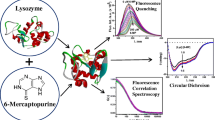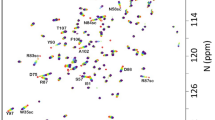Abstract
A reagent (I, N4-(9′-fluorenylmethyloxycarbonyl-4-amino-1-oxyl-4-succinimidyloxycarbonyl-2,2,6,6-tetramethylpiperidine)) that acylates calmodulin specifically at lysines 75 and 148 was recently described (Jackson and Puett, 1984). Chromatographic procedures are described that permit purification to apparent homogeneity of a 1 : 1 and a 2 : 1 adduct characterized by modification at just Lys 75 or at Lys 75 and Lys 148, respectively. These adducts are suitable for detailed characterization in an effort to provide information on calmodulin structure-function relationships. The adducts were incapable of, or exhibited low potency (e.g., 0.1% that of calmodulin) in, stimulating the activity of an activatable bovine brain cyclic nucleotide phosphodiesterase (3′,5′-cyclic AMP 5′-nucleotidehydrolase, EC 3.1.4.17) preparation. Electron paramagnetic resonance (EPR) spectroscopy of the adducts yielded rotational correlation times of approximately 3–6 nsec, in agreement with the expected value for a hydrated protein of this molecular weight (∼5–7 nsec). Thus, the nitroxide reporter group appears to monitor closely the motion of the protein, and there is no evidence of a major conformational change in the derivative relative to calmodulin. Interestingly, removal of the fluorenylmethyloxycarbonyl portion from the 1 : 1 adduct to give a “deprotected” 1 : 1 adduct resulted in apparent greater mobility of the probe, since the rotational correlation coefficient was found to be ∼1 nsec. Circular dichroic spectra were obtained over the wavelength interval 200–250 nm on the two adducts and on the deprotected 1 : 1 adduct. These derivatives, like calmodulin, exhibited a Ca2+-mediated increase in helicity, and the spectra of the adducts in the presence of a chelating agent and in the presence of saturating Ca2+ were similar to those obtained for calmodulin. Thus, the adducts have secondary structures similar to the native protein. Proton nuclear magnetic resonance spectra were determined in the aromatic region (∼6–8 ppm) for the deprotected 1 : 1 adduct before and after reduction of the nitroxide with ascorbate. The nitroxide had little effect on the chemical shifts of the two tyrosines and the single histidine relative to calmodulin, although the histidine C4 resonance was markedly altered by the addition of ascorbate. In order to explore in greater detail the tertiary structure of the 1 : 1 adduct, a reagent similar to I, but not paramagnetic, was synthesized. This compound II, α-N-(9′-fluorenylmethyloxycarbonyl)alanine N-hydroxysuccinimide ester, like I, forms a 1 : 1 adduct at Lys 75 and a 2 : 1 adduct at Lys 75 and Lys 148. Proton NMR spectra of adducts with II were not complicated by the relaxation effects arising from adducts with I; thus more definitive assignments could be made to the upfield resonances, including the fluorene protons. Again, it was possible to conclude that adduct formation had no major effect on the tertiary structure of the protein as monitored by chemical shifts associated with various residues. We conclude that modification of just Lys 75, a residue in the long connecting helix of calmodulin, does not lead to major changes in protein conformation but does interfere with the ability of calmodulin to stimulate an activatable form of bovine brain cyclic nucleotide phosphodiesterase.
Similar content being viewed by others
References
Babu, Y. S., Sack, J. S., Greenhough, T. J., Bugg, C. E., Means, A. R., and Cook, W. J. (1985). Nature (Lond.) 315, 37–40.
Bobst, A. M. (1979). In Spin Labeling II: Theory and Applications (Berliner, L. J., ed.), Academic Press, New York, pp. 291–345.
Buccigross, J. M., and Nelson, D. J. (1986). Biochem. Biophys. Res. Commun. 138, 1243–1249.
Cantor, C. R., and Schimmel, P. R. (1980). In Biophysical Chemistry, Part 2, W. H. Freeman, San Francisco, p. 461.
Cohn, E. J., and Edsall, J. T. (1943). In Proteins, Amino Acids and Peptides, Reinhold, New York, pp. 370–375.
Dalgarno, D. C., Klevit, R. E., Levine, B. A., Williams, R. J. P., Drabikowsky, Z., and Drabikowski, W. (1984). Eur. J. Biochem. 138, 281–289.
Edelman, A. M., Takio, K., Blumenthal, D. K., Hansen, R. S., Walsh, K. A., Titani, K., and Krebs, E. G. (1985). J. Biol. Chem. 260, 11275–11285.
Faust, F. M., Slisz, M., and Jarrett, H. W. (1987). J. Biol. Chem. 262, 1938–1941.
Giedroc, D. P., Sinha, S. K., Brew, K., and Puett, D. (1985). J. Biol. Chem. 260, 13406–13413.
Hewgley, P. B., and Puett, D. (1980). Ann. N.Y. Acad. Sci. 356, 20–32.
Ikura, M., Hiroaki, T., Hikichi, K., Mikuni, T., Yazawa, M., and Yagi, K. (1983). Biochemistry 22, 2573–2579.
Ikura, M., Minowa, O., and Hikichi, K. (1985). Biochemistry 24, 4264–4269.
Jackson, A. E. (1985). Ph.D. dissertation, Vanderbilt University, Nashville, Tennessee.
Jackson, A. E., and Puett, D. (1984). J. Biol. Chem. 259, 14985–14992.
Jackson, A. E., and Puett, D. (1986). Biochem. Pharmacol. 35, 4395–4400.
Jackson, A. E., Carraway, K. L.Jr., Puett, D., and Brew, K. (1986). J. Biol. Chem. 261, 12226–12232.
Klee, C. B., and Vanaman, T. C. (1982). Adv. Protein Chem. 35, 213–321.
Klevit, R. E., Blumenthal, D. K., Wemmer, D. E., and Krebs, E. G. (1985). Biochemistry 24, 8152–8157.
Kuznetsov, A. N., Wasserman, A. M., Volkov, A.Jr., and Korst, N. N. (1971). Chem. Phys. Lett. 12, 103–106.
Lukas, T. J., Prystowsky, M. B., and Erickson, B. W. (1981). Proc. Natl. Acad. Sci. USA 78, 2791–2793.
Newton, D. L., Burke, T. R.Jr., Rice, K. C., and Klee, C. B. (1983) Biochemistry 22, 5472–5476.
Ni, W-C., and Klee, C. B. (1985). J. Biol. Chem. 260, 6974–6981.
Puett, D., Giedroc, D. P., Tollefson, S., and Ling, N. (1983). Peptides 4, 191–194.
Seamon, K. B. (1980) Biochemistry 19, 207–215.
Sears, D. W., and Beychok, S. (1973). In Physical Principles and Techniques of Protein Chemistry, Part C (Leach, S. J., ed.), Academic Press, New York, pp. 445–593.
Smith, I. C. P. (1972). In Biological Applications of Electron Spin Resonance (Swartz, H. M., Bolton, J. R., and Borg, D. C., eds.), Wiley-Interscience, New York, pp. 490–493.
Walsh, M., and Stevens, F. C. (1977). Biochemistry 16, 2742–2749.
Walsh, M., Stevens, F. C., Oikawa, K., and Kay, C. M. (1978). Biochemistry 17, 3924–3930.
Watterson, D. M., Sharief, F., and Vanaman, T. C. (1980) J. Biol. Chem. 255, 962–971.
Author information
Authors and Affiliations
Rights and permissions
About this article
Cite this article
Jackson, A.E., Harris, T.M. & Puett, D. Characterization of specific fluorenylmethyloxycarbonyl-containing calmodulin adducts by spectroscopy and phosphodiesterase stimulation. J Protein Chem 6, 497–515 (1987). https://doi.org/10.1007/BF00276736
Received:
Published:
Issue Date:
DOI: https://doi.org/10.1007/BF00276736




